Display Explanation: Welcome to "Baths of Olympus," a unique installation designed to immerse visitors in the world of Greco-Roman mythology and its exploration of the multifaceted nature of sexuality. This exhibition is housed in a room made specifically to emmulate that of a Greco-Roman bathhouse, complete with marble walls, flooring, and columns. As you enter the room, the first painting, Frederic Leighton's "Venus Disrobing for the Bath," is positioned in a display near the entrance. Draped over the display are rose garlands with doves and sparrows nestled within. The painting is carefully illuminated so as to draw attention to Venus, the embodiment of beauty and desire, as she delicately reveals her enchanting form. The positioning of Venus near the entrance symbolizes the initial awakening of sensual exploration and sets the tone for the rest of the installation. Moving deeper into the room, visitors will find a grand marble fountain within a large pool adorned with intricate carvings inspired by Greeco-Roman mythology. The fountain serves both as the "Bath of Olympus" itself and as a central gathering point where visitors can pause and reflect on the themes and emotions evoked by the artwork. This is also where the second piece, Frederic Leighton's, "The Bath of Psyche," is suspended above the fountain, seemingly floating in midair. The placement allows visitors to engage with the ethereal beauty of Psyche, a mortal woman who captivated the gods with her allure and invites them to contemplate the transformative power of love and the depths of passion that can be reached through the exploration of one's desires. The final part to the installation is Guillaume Debufe's "Diane Leaving Her Bath," found on a pedestal in a more secluded part of the exhibit. Surrounded by lush greenery and an array of woodland creatures, Diane, the Roman goddess of the hunt and the moon, can be taken to symbolize the multifaceted nature of human desire and the different perspectives from which one can view sexuality. Throughout the installation, soft ambient music fills the room, composed of melodies chosen to invoke a sense of mystery, sensuality, and introspection. The music serves to heighten the emotional impact of the artworks and creates an immersive atmosphere.To encourage deeper engagement, there are seating areas with comfortable cushions and drapery placed among the room, so that visitors can sit and absorb the beauty and symbolism of the artworks at their own pace. By combining the these three paintings, the Greco-Roman bathhouse, and thoughtful presentation techniques, the installation aims to inspire visitors to explore the interplay between beauty, desire, and the human experience.
Installation Note: Going into this assignment, I wanted to be able to explore sexuality and desire through the use of mythology, as Venus, Psyche, and Diane, in particular, all have stories revolving around these ideas. The three art pieces selected for this installation revolve around the theme of sexuality as a normal, casual thing seen in day-to-day life. Each artwork contributes to the overarching narrative of the installation by offering unique perspectives and using mythology to describe the human experience. Leighton's "Venus Disrobing for the Bath" portrays Venus, the goddess of love and desire, removing her dress as she prepares to take a bath, in a way that highlights the raw beauty and vulnerability of the human body. Venus becomes a symbol of unapologetic self-expression and serves as an embodiment of the freedom to embrace and celebrate one's desires (albeit, often at the expense of others...) Continuing the narrative, Leighton's "The Bath of Psyche" has a very similar feel to the last painting, but the mythological tale of Psyche, is much different: she is a mortal woman who becomes the lover of the god Eros, son of Aphrodite/Venus, the very same person who was so jealous of Psyche's beauty that she wanted her gone. Psyche's story highlights the depths of passion and love that can be attained through the exploration of one's desires, as well as the idea that love is worth fighting for. In contrast to Leighton's works, Guillaume Debufe's "Diane Leaving Her Bath" introduces a different perspective on sexuality. The painting portrays Diane, the virgin goddess of the hunt and the moon, as she emerges from her bath. Diane represents a powerful, untamed femininity, without conforming to societal expectations (i.e. she never takes a lover, never marries, etc.). The connections and contrasts between these art pieces within the installation serve to depict the spectrum of sexuality. From the chaos brought on by Venus' vanity and affections, to a more innocent type of love portrayed in Psyche, and finally to the wild and unrestrained nature of womanhood embodied by Diane, the installation aims to celebrate the diversity of human experiences and challenge preconceived notions about sexuality.
Dubufe, Guillaume. Diana leaving her bath. 1893, Private Collection. Accessed 2/28/2024. https://commons.wikimedia.org/wiki/File:Guillaume_Dubufe_Diane.jpg
Leighton, Frederick. The Bath of Psyche. 1879, Tate Britain, London. Accessed 2/28/2024. https://commons.wikimedia.org/wiki/File:Frederic_Leighton_The_Bath_of_P…
Leighton, Frederick. Venus Disrobing for the Bath. 1867, Private Collection. Accessed 2/28/2024. https://commons.wikimedia.org/wiki/File:Frederic_Leighton_-_Venus_Disro…

